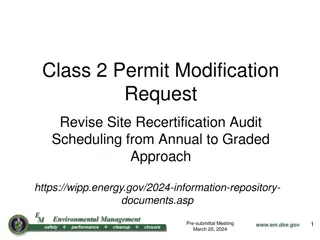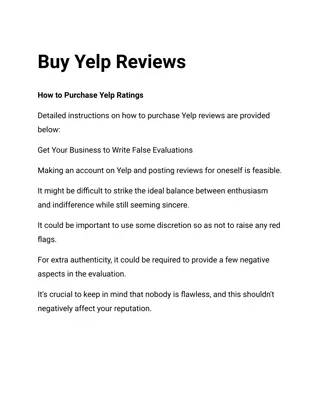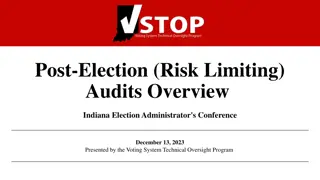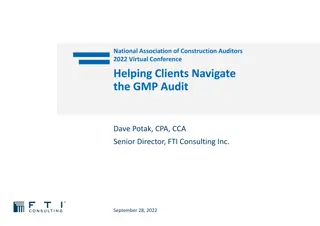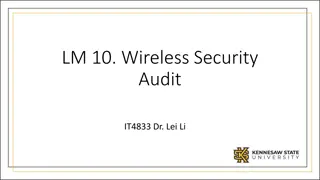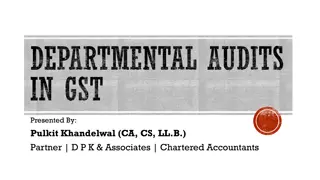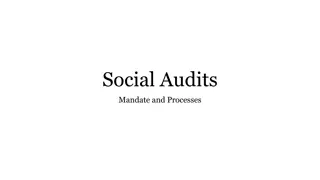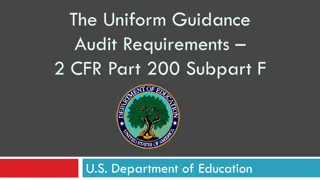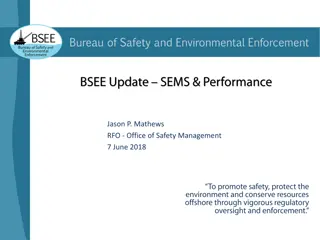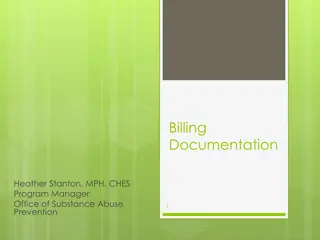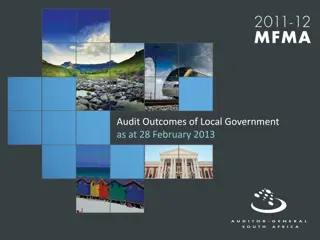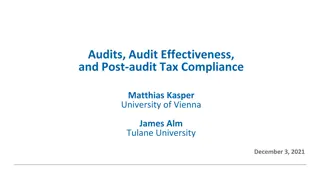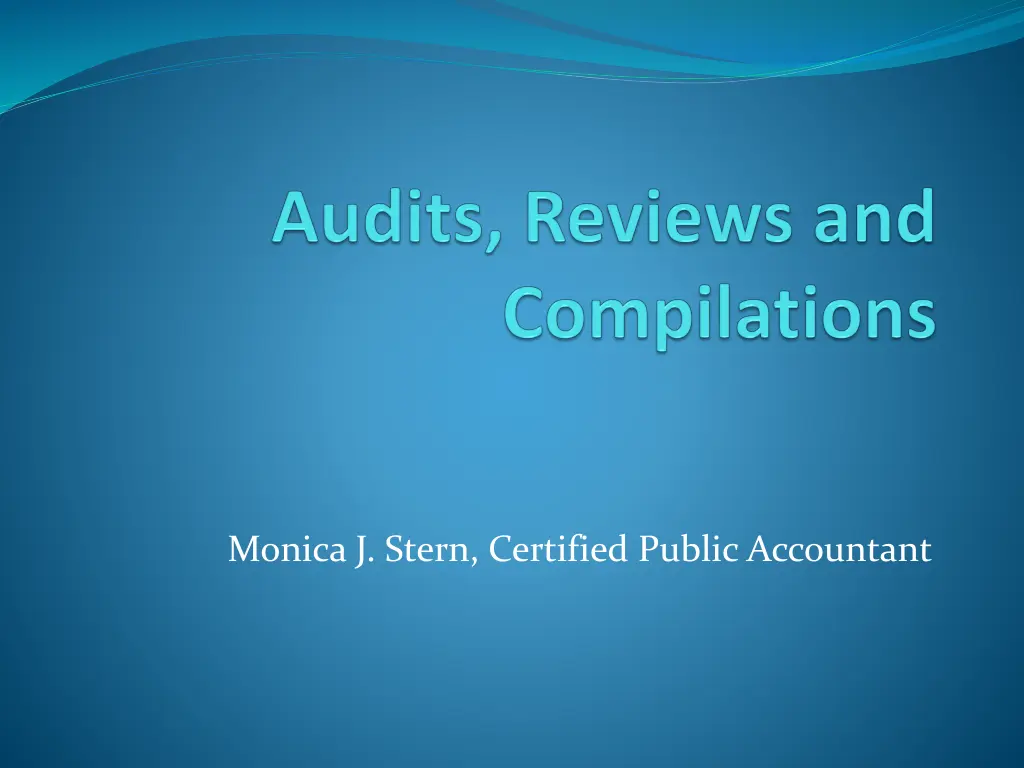
Understanding Audit Processes for Certified Public Accountants
Learn about audits, key concepts, who requires an audit, ECFA audit requirements, and how to determine readiness for an audit in the financial world. Gain insights into the responsibilities of a CPA and the importance of financial statement accuracy.
Download Presentation

Please find below an Image/Link to download the presentation.
The content on the website is provided AS IS for your information and personal use only. It may not be sold, licensed, or shared on other websites without obtaining consent from the author. If you encounter any issues during the download, it is possible that the publisher has removed the file from their server.
You are allowed to download the files provided on this website for personal or commercial use, subject to the condition that they are used lawfully. All files are the property of their respective owners.
The content on the website is provided AS IS for your information and personal use only. It may not be sold, licensed, or shared on other websites without obtaining consent from the author.
E N D
Presentation Transcript
What is an audit? An audit is a prescribed process a Certified Public Accountant applies to your financial statements in order to provide the end user with an opinion as to whether the financial statements are presented fairly, in all material respects, in conformitywith one of the acceptable methods of accounting in the US.
Key Concepts Prescribed Process Generally Accepted Auditing Standards must be followed by the CPA and include obtaining an understanding of your internal control and assessing fraud risk. Your Financial Statements The statements being audited are yours, not the auditor s, and must be prepared in accordance with an approved method of accounting.
Key Concepts End User The auditor is responsible to the end user, not to the client . End users may be banks, donors, grantors, members or the general public. Opinion The auditor s report may include an opinion, or may include a disclaimer of opinion or an adverse opinion as to whether the financial statements are presented fairly.
Key Concepts In Conformity the financial statements must be in conformity with a recognized method of accounting; GAAP (generally accepted accounting principles), cash basis, modified cash basis or income tax basis.
Who Requires an Audit? Banks through loan covenants Grantors Banks for new financing ECFA or other membership Governmental Grants Bylaws requirement
ECFA Audit Requirements An audit is required only if annual revenues are above $3,000,000 and must be in accordance with GAAP.
How to Know if you are Ready to be Audited? Have you established internal controls over your major functions? Are the controls written, documented and tested? Are the controls monitored to be sure the controls are actually being adhered to? Have you identified your greatest risks including financial, market and other risks? Have you performed a compensation study? Have you had on-going CPA support?
How to Know if you are Ready to be Audited? Have you identified conflicts of interest in accordance with your written policies? Are you in compliance with all laws and regulations? Are you able to document the use of restricted funds? Are your articles and bylaws up-to-date and are you adhering to them? Are your books and records maintained in accordance with generally accepted accounting principles? Have you evaluated the needs of the end users to ensure the audit will be an effective tool?
How to Know if you are Ready to be Audited? Does your staff and the board have the time and expertise to participate in an audit? Will the cost of an audit unduly affect your general and administrative cost percentage? Do you have members of the board who are willing and have the expertise to function as the audit committee?
The Audit Committee Functions independently between the board and the auditor Develops the criteria for the audit and the audit firm selection process Reviews the qualifications of the auditor Discusses concerns or areas the committee would like the auditor to give attention to Meets with the auditor prior to the audit and during the audit Reviews the reports and findings and presents results to the board MUST UNDERSTAND ACCOUNTING AND FINANCIAL MATTERS!
Benefits of an Audit Adds a layer of accountability to donors Forces the accounting to be done correctly and timely and not later May help you stay up-to-date on accounting and law changes; improved internal controls May detect fraud (or may not) May make it easier to obtain financing for building projects
Downsides to an Audit Cost in dollars audits are expensive! Cost in staff time audits are very intrusive Audit may not be that important to donors If you are not prepared for an audit, the auditor s report may be very detrimental May not provide the answer to are we doing everything right?
Cost of an Audit in Time and Dollars How much is a car? Used, new? Ferrari or Kia? Audit costs vary widely depending on the entity. Size is not a great indicator of cost most procedures must be performed for all audits, even for small entities. Most audits require staff to prepare financial statements, policies and procedures, and gather documents in advance of auditor s visit. Field work is never less than two days and could be more. Much more time and cost in an initial audit.
Common Reasons Organizations Think They Need an Audit We want to make sure we are doing everything right! Our books are a mess and we want an audit to straighten them out. We think our bookkeeper is stealing. Our new treasurer is taking over and wants an audit. Our bylaws say we will have an audit.
Agreed Upon Procedures Engagement Has elements similar to audit both are attestation functions. CPA and organization agree upon certain procedures to be done. Must be testable and not vague cannot say you are doing everything right , but might say of the 40 disbursements tested, two were not support by a vendor invoice. CPA performs the agree-upon procedures and reports back to the board.
Benefits/Downsides for Agreed- Upon Procedures Engagement Benefits Cost is much lower than other engagements Gets to the heart of what you want to know Specific and understandable language Can provide a roadmap for improvements if the CPA also issues a management letter of comments Great first step for an audit in the future may help you know what needs correction Boards get it
Benefits/Downsides for Agreed- Upon Procedures Engagement Downsides CPA must restrict report for internal use or only to named, specific parties who agree to the procedures (i.e. bank or Police Department) Doesn t provide financial information in financial statement form narrative only May not answer all your questions CPA only does the work agreed-upon Generally won t help with bank financing, but may be a part of the process
What is a Review? A review is a prescribed process a Certified Public Accountant applies to your financial statements in order to provide the end user with limited assurance that there are no material modifications that should be made to the financial statements for them to be in conformitywith one of the acceptable methods of accounting in the US.
Who Requires a Review? Banks and other lenders generally request reviews, rather than audits Donors Grantors ECFA allows for organizations with $1 million to $3 million in revenue
Benefits/Downsides of a Review Benefits Much less costly than an audit Financial statements look exactly the same as audited financial statements Generally done in CPA office vs. your office Less time required of staff
Benefits/Downsides of a Review Downsides Limited assurance lower level of assurance No requirements to consider internal control No management letter required, although you can request one as part of the engagement May not detect fraud Relies on analytical procedures and questions of client and does not consider source documentation
What is a Compilation? An compilation is a prescribed process a Certified Public Accountant applies to your financial statements in order to assist management in presenting financial information to the end user with no assurance that there are no material modifications that should be made to the financial statements to be in conformity with one of the acceptable methods of accounting in the US.
Who Requires a Compilation? Banks and other lenders generally request compilations or reviews Donors Grantors ECFA allows for organizations with less than $1 million in revenue
Benefits/Downsides of a Compilation Benefits Much less costly than an audit or review Financial statements look exactly the same as audited or reviewed financial statements Generally done in CPA office vs. your office Less time required of staff
Benefits/Downsides of a Compilation Downsides NO assurance No requirement to consider internal control No management letter required, although you can request one as part of the engagement Likely will not detect fraud Relies heavily on management s numbers CPA is looking only for obvious error
Accounting Resources Evangelical Council for Financial Accountability www.ecfa.org AICPA Not-for-Profit Audit Committee Toolkit http://www.aicpa.org/interestareas/businessindustrya ndgovernment/resources/notforprofitresourcecenter/ pages/aicpanot-for- profitauditcommitteetoolkitdownloads.aspx


